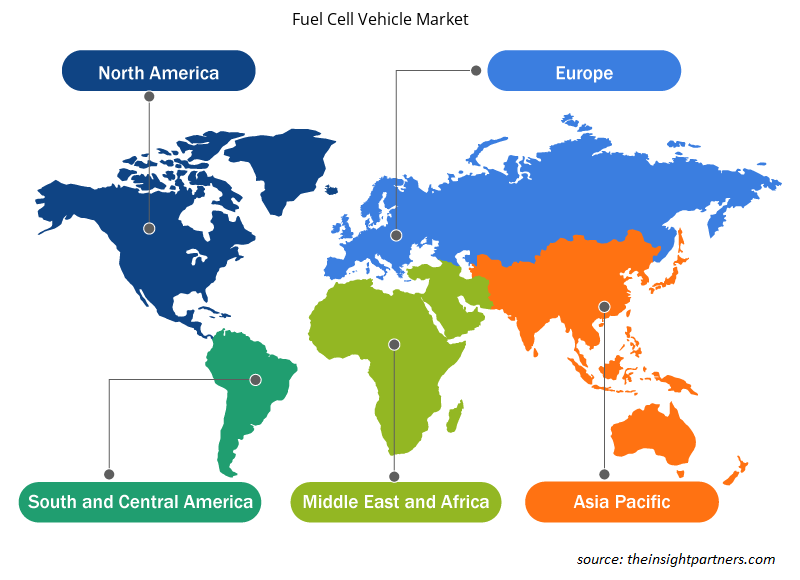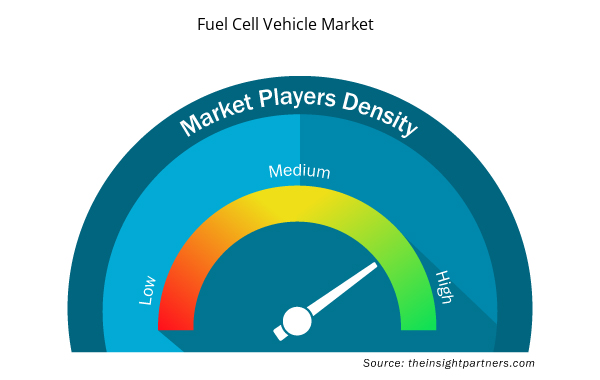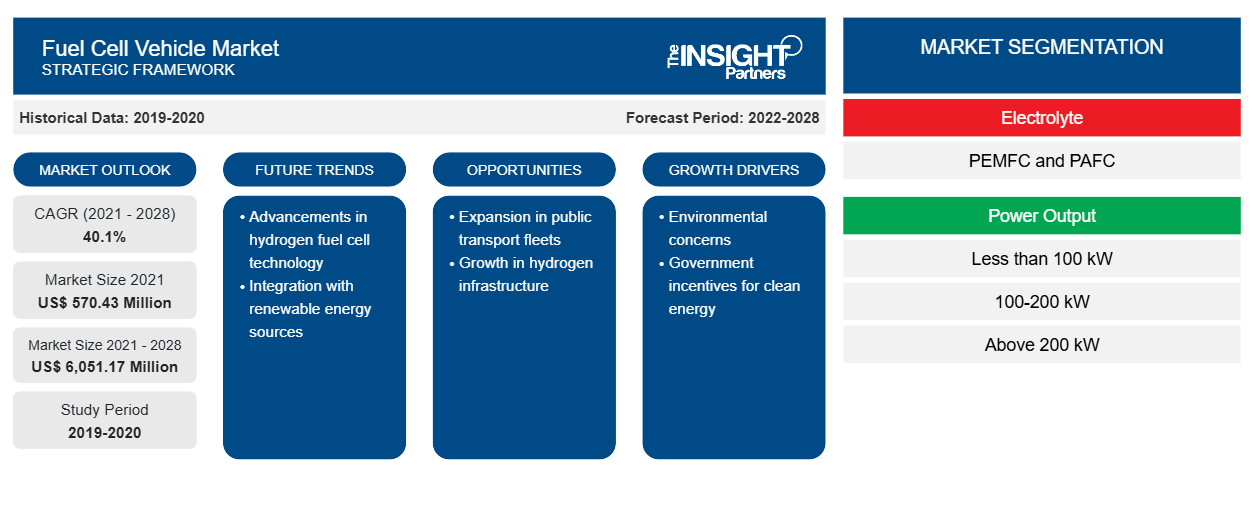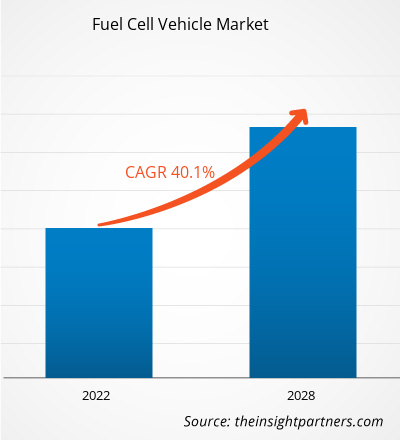[연구보고서] 연료전지차 시장 규모는 2021년 5억7,043만달러에서 2028년 6,051.17만달러로 성장할 것으로 전망되며, 2021~2028년 연평균 성장률은 40.1%로 추산됩니다.
분석가 관점:
최근 몇 년 동안 연료 전지 차량 시장은 기존 가솔린 차량에 대한 유망한 대안으로 상당한 주목과 추진력을 얻었습니다. 연료 전지 차량(FCV)은 수소 연료 전지로 구동되며, 수소와 산소 간의 화학 반응을 통해 전기를 유도하여 수증기만을 배출합니다. FCV의 주요 장점 중 하나는 환경 친화성입니다. 수증기만 배출하므로 온실 가스 배출과 대기 오염을 줄이는 데 기여하여 기후 변화와 도시 오염에 대한 글로벌 우려를 해결합니다. 이러한 특성으로 인해 연료 전지 기술을 채택하고 개발하기 위한 정부 지원과 인센티브가 증가했습니다. 시장 성장과 관련하여 연료 전지 차량 시장은 꾸준한 진전을 보였습니다.FCV )는 수소 연료 전지로 구동되며, 수소와 산소 사이의 화학 반응을 통해 전기를 유도하여 수증기만을 배출합니다. FCV 의 주요 장점 중 하나 는 환경 친화성입니다. 수증기만 배출하기 때문에 온실 가스 배출과 대기 오염을 줄이는 데 기여하여 기후 변화와 도시 오염에 대한 세계적 우려를 해결합니다. 이러한 특성으로 인해 연료 전지 기술을 채택하고 개발하기 위한 정부 지원과 인센티브가 증가했습니다. 시장 성장과 관련하여 연료 전지 차량 시장은 꾸준한 진전을 보였습니다.
자동차 제조업체와 기술 회사는 연료 전지 차량의 효율성, 성능 및 경제성을 개선하기 위해 연구 개발에 많은 투자를 해왔습니다. 그 결과, FCV의 범위가 크게 증가하여 제한된 주행 범위와 관련된 초기 문제 중 하나를 해결했습니다. 연료 전지 차량 시장은 여전히 기존 내연 기관 및 전기 자동차 에 비해 비교적 작지만 앞으로 몇 년 동안 상당한 성장을 경험할 것으로 예상됩니다. 연료 전지 기술과 인프라 개발의 발전과 더불어 지속 가능한 운송 솔루션에 대한 수요 증가는 시장 확장을 촉진할 가능성이 높습니다. 또한 자동차 제조업체, 에너지 회사 및 정부 간의 파트너십과 협력은 연료 전지 차량 시장의 성장을 촉진하고 있습니다. 이러한 제휴는 연료 전지 차량의 배치를 가속화하고 연구 개발을 촉진하는 것을 목표로 합니다.FCV는 상당히 증가하여 제한된 주행 범위와 관련된 초기 우려 중 하나를 해결했습니다. 연료 전지 차량 시장은 여전히 기존 내연 기관과 비교하여 비교적 작지만
시장 개요:
연료 전지 차량 시장은 수소를 연료원으로 사용하여 전기를 생성하는 연료 전지 기술로 구동되는 차량에 초점을 맞춥니다. 이 시장은 환경적 우려의 증가와 지속 가능한 운송 옵션에 대한 필요성으로 인해 눈에 띄는 성장을 보였습니다. 정부 규제와 인센티브는 연료 전지 차량 채택을 촉진하는 데 중요한 역할을 했습니다. 연료 전지 기술의 발전, 업계 이해 관계자 간의 협력, 지속적인 연구 개발 노력은 시장 확장을 더욱 촉진했습니다. 높은 비용과 제한된 인프라와 같은 과제는 여전히 남아 있지만, 기술이 향상되고 더 깨끗한 운송 솔루션에 대한 수요가 계속 증가함에 따라 시장은 미래 성장에 상당한 잠재력을 가지고 있습니다.
귀하의 요구 사항에 맞게 이 보고서를 사용자 정의하세요
이 보고서의 일부 또는 국가 수준 분석, Excel 데이터 팩을 포함하여 모든 보고서에 대한 사용자 정의를 무료로 받을 수 있으며 신생 기업 및 대학을 위한 훌륭한 혜택과 할인 혜택을 이용할 수 있습니다.
- 이 보고서의 주요 시장 동향을 알아보세요.이 무료 샘플에는 시장 동향부터 추정 및 예측까지 다양한 데이터 분석이 포함됩니다.
시장 동인:
환경적 우려 증가로 연료 전지 자동차 시장 성장 촉진
증가하는 환경적 우려는 연료 전지 차량 시장 성장의 중요한 원동력으로 부상했습니다. 사람들이 전통적인 가솔린 구동 차량이 환경에 미치는 해로운 영향에 대해 더 많이 알게 되면서 더 깨끗하고 친환경적인 교통 수단에 대한 수요가 증가하고 있습니다. 이러한 높아진 환경 의식은 연료 전지 차량에 유리한 시장 환경을 조성했습니다. 연료 전지 차량은 풍부하고 깨끗한 에너지 운반체인 수소를 연료원으로 사용합니다. 수소가 연료 전지에서 산소와 혼합되면 전기가 생성되고 유일한 부산물은 수증기입니다. 이러한 무공해 작동은 환경을 의식하는 소비자를 유치하는 데 중요한 요소입니다. 대기 오염과 온실 가스 배출에 대한 인식이 높아짐에 따라 정부와 규제 기관은 더욱 엄격한 환경 규정을 부과했습니다. 많은 국가와 지역에서 탄소 배출을 줄이고 지속 가능한 교통 수단을 장려하기 위한 야심 찬 목표를 설정했습니다. 이에 따라 자동차 제조업체는 이러한 규정을 충족하고 환경을 의식하는 고객 기반에 어필하기 위해 포트폴리오의 일부로 연료 전지 차량을 개발하는 데 점점 더 주력하고 있습니다.
또한 연료 전지 기술의 발전으로 연료 전지 차량의 성능과 효율성이 크게 향상되었습니다. 이러한 차량은 이제 더 긴 주행 거리와 더 빠른 연료 보급 시간을 제공하여 일상 생활에 더 실용적입니다. 수소 연료 보급소를 위한 성장하는 인프라는 또한 연료 전지 차량의 채택과 관련된 주요 과제 중 하나를 해결함으로써 연료 전지 차량의 시장 성장을 지원하고 있습니다. 또한 자동차 제조업체, 에너지 회사 및 정부의 연료 전지 기술에 대한 투자와 연구 노력이 증가함에 따라 연료 전지 차량의 개발 및 상용화가 가속화되었습니다. 이러한 투자는 연료 전지의 기술적 역량을 향상시켰을 뿐만 아니라 생산 비용을 줄이는 데 기여하여 시장에서 더 경쟁력을 갖추게 되었습니다.
세그먼트 분석:
차량 유형에 따라 연료 전지 차량 시장은 승용차, 버스, 트럭 및 경 상용차 로 세분화됩니다 . 승용차 부문은 2020년에 시장 점유율이 가장 높았으며 예측 기간 동안 시장에서 가장 높은 CAGR을 기록할 것으로 추정됩니다. 승용차 부문은 다양한 요인으로 인해 연료 전지 차량 시장에서 가장 큰 점유율을 차지했습니다. 탄소 배출 감소와 지속 가능한 교통 수단으로의 전환에 대한 글로벌 관심이 커지면서 연료 전지 차량에 대한 수요가 증가했습니다. 자동차 제조업체는 연료 전지 승용차를 개발하고 상용화하여 효율성, 범위 및 경제성을 개선하는 데 투자했습니다.
다양한 연료 전지 승용차 모델의 가용성, 수소 인프라의 발전, 긴 주행 거리와 짧은 재급유 시간과 같은 연료 전지 기술의 이점이 이 부문의 성공에 기여했습니다. 전반적으로 승용차 부문은 자동차 산업에서 연료 전지 기술의 수용과 실행 가능성이 증가하고 있음을 반영합니다.
지역 분석:
아시아 태평양 연료 전지 차량 시장은 2021년에 3억 169만 달러 규모였으며 2028년까지 4,113.9백만 달러에 도달할 것으로 예상되며 예측 기간 동안 45.2%의 CAGR로 성장할 것으로 예상됩니다. 아시아 태평양 지역은 연료 전지 차량 시장에서 지배적인 세력으로 부상했습니다. 방대한 인구, 빠른 도시화, 오염 및 기후 변화에 대한 우려가 커지면서 이 지역은 보다 깨끗하고 지속 가능한 교통 대안을 적극적으로 수용했습니다. 이 지역의 지배력에 기여하는 주요 요인 중 하나는 연료 전지 차량 채택을 촉진하는 강력한 정부 지원과 정책입니다. 일본, 한국, 중국과 같은 국가는 연료 전지 차량 사용을 장려하기 위해 유리한 규정, 세금 인센티브 및 보조금을 시행했습니다. 이러한 조치는 제조업체, 투자자 및 소비자 모두에게 유리한 환경을 조성하여 시장 성장을 촉진했습니다. 특히 일본은 연료 전지 차량 개발 및 배포의 최전선에 있었습니다. 일본 정부는 전국에 수소 충전소 네트워크를 구축하는 것을 목표로 수소 인프라 개발에 대한 야심찬 목표를 설정했습니다.
또한 Toyota와 Honda와 같은 주요 일본 자동차 제조업체는 연료 전지 차량 연구 및 개발에 상당한 투자를 하여 Toyota Mirai와 Honda Clarity와 같은 모델을 상용화했습니다. 한국도 연료 전지 차량 시장에서 놀라운 진전을 이루었습니다. 정부는 수소 인프라 개발을 우선시하고 연료 전지 버스와 상용차의 배치를 적극 지원했습니다. 한국에 본사를 둔 현대와 기아와 같은 회사는 현대 Nexo와 Kia Niro와 같은 혁신적인 모델을 통해 연료 전지 차량 채택을 촉진하는 데 중요한 역할을 했습니다. 인구가 많고 대기 오염에 대한 우려가 커지는 중국도 연료 전지 차량의 잠재력을 인식했습니다. 중국 정부는 국가를 수소 기술 분야의 글로벌 리더로 자리 매김하기 위해 연료 전지 차량 생산에 대한 관대한 보조금과 목표를 도입했습니다. BYD, BAIC, Geely를 포함한 여러 중국 자동차 제조업체는 연료 전지 차량 개발에 많은 투자를 하여 이 지역의 전반적인 시장 지배력에 기여했습니다. 더욱이 아시아 태평양 지역은 강력한 제조 역량과 기술 전문성의 혜택을 받고 있습니다. 확립된 자동차 제조업체와 강력한 공급망의 존재는 연료 전지 차량의 생산과 상용화를 용이하게 했습니다. 또한 이 지역은 첨단 연구 개발 센터, 학술 기관, 산업과 학계 간의 파트너십을 자랑하며, 연료 전지 기술의 기술적 발전을 주도합니다.
주요 플레이어 분석:
연료 전지 차량 시장 분석은 현대자동차, 도요타자동차, 커민스, 제너럴 모터스, AB 볼보, 혼다자동차, 리버심플, 하이존 모터스, 다임러 AG, 발라드 파워 시스템 등의 업체로 구성되어 있습니다. 연료 전지 차량 업체 중에서 커민스와 현대자동차는 다양한 제품 포트폴리오를 제공하기 때문에 주요 업체입니다.
연료 전지 차량 시장 지역 통찰력
Insight Partners의 분석가들은 예측 기간 동안 연료 전지 차량 시장에 영향을 미치는 지역적 추세와 요인을 철저히 설명했습니다. 이 섹션에서는 북미, 유럽, 아시아 태평양, 중동 및 아프리카, 남미 및 중미의 연료 전지 차량 시장 세그먼트와 지리에 대해서도 설명합니다.

- 연료 전지 차량 시장에 대한 지역별 특정 데이터 얻기
연료 전지 차량 시장 보고서 범위
| 보고서 속성 | 세부 |
|---|---|
| 2021년 시장 규모 | 5억 7,043만 달러 |
| 2028년까지 시장 규모 | 6,051.17백만 달러 |
| 글로벌 CAGR (2021-2028) | 40.1% |
| 역사적 데이터 | 2019-2020 |
| 예측 기간 | 2022-2028 |
| 다루는 세그먼트 | 전해질로
|
| 포함된 지역 및 국가 | 북아메리카
|
| 시장 선도 기업 및 주요 회사 프로필 |
|
연료 전지 차량 시장 참여자 밀도: 비즈니스 역학에 미치는 영향 이해
연료 전지 차량 시장은 소비자 선호도의 변화, 기술 발전, 제품의 이점에 대한 인식 증가와 같은 요인으로 인해 최종 사용자 수요가 증가함에 따라 빠르게 성장하고 있습니다. 수요가 증가함에 따라 기업은 제품을 확장하고, 소비자의 요구를 충족하기 위해 혁신하고, 새로운 트렌드를 활용하여 시장 성장을 더욱 촉진하고 있습니다.
시장 참여자 밀도는 특정 시장이나 산업 내에서 운영되는 회사나 기업의 분포를 말합니다. 주어진 시장 공간에 얼마나 많은 경쟁자(시장 참여자)가 존재하는지 그 규모나 총 시장 가치에 비해 나타냅니다.
연료전지 자동차 시장에서 활동하는 주요 기업은 다음과 같습니다.
- 현대자동차
- 토요타 자동차 주식회사
- 커민스 주식회사
- 제너럴 모터스
- AB 볼보
면책 조항 : 위에 나열된 회사는 어떤 특별한 순서에 따라 순위가 매겨지지 않았습니다.

- 연료 전지 자동차 시장의 주요 주요 업체 개요를 알아보세요
최근 개발 사항:
합병 및 인수와 같은 무기적 및 유기적 전략은 연료 전지 차량 시장에서 회사들에 의해 널리 채택됩니다. 최근 몇 가지 주요 시장 개발은 다음과 같습니다.
- 2021년 4월, SAFRA Materiel Transport Public과 Symbio(Michelin과 Faurecia의 자회사)는 수소 버스 1,500대를 제조하는 계약을 체결했습니다.
- 2020년 12월, 토요타는 새로운 차량 미라이를 출시했습니다. 이 차량은 수소를 연료로 사용하는 연료 전지로 구동됩니다. 토요타 미라이는 142.2리터 연료 탱크를 갖추고 있으며, 연료 전지는 최대 출력 171마력, 최대 토크 221Nm를 제공합니다.
- 역사적 분석(2년), 기준 연도, CAGR을 포함한 예측(7년)
- PEST 및 SWOT 분석
- 시장 규모 가치/양 - 글로벌, 지역, 국가
- 산업 및 경쟁 환경
- Excel 데이터 세트


- Vaginal Specula Market
- Electronic Signature Software Market
- Clear Aligners Market
- Extracellular Matrix Market
- Lymphedema Treatment Market
- Biopharmaceutical Contract Manufacturing Market
- Online Recruitment Market
- Virtual Pipeline Systems Market
- Medical Enzyme Technology Market
- Identity Verification Market

Report Coverage
Revenue forecast, Company Analysis, Industry landscape, Growth factors, and Trends

Segment Covered
This text is related
to segments covered.

Regional Scope
North America, Europe, Asia Pacific, Middle East & Africa, South & Central America

Country Scope
This text is related
to country scope.
자주 묻는 질문
Hyundai Motor Company, Toyota Motor Corporation, Ballard Power Systems Inc, Hyzon Motors, and Daimler AG are among the leading players offering innovative solution in the market .
Increasing Demand for Clean Energy
Declining Cost of Green Hydrogen
The forecast period for the global fuel cell vehicles market is 2021 to 2028.
The fuel cell vehicle market is expected to witness steady growth during the forecast period from 2021 to 2028, owing to the rising demand from passenger car segment.
APAC is likely to register for the highest CAGR in the fuel cell vehicles market during the forecast period.
The region includes major nations such as India, China, Japan, South Korea, and Australia. South Korea and China are the fastest-growing manufacturing markets in APAC.
Adoption of heavy duty trucks has increased considerably in the recent years. For instance, China witnessed a rise in the registrations of electric vehicles in 2020 by 10% in comparison to 2019. Further, the new registrations for heavy duty vehicles increased by 23% in Europe. Companies operating in the global truck market are working progressively towards the adoption of fuel cell trucks due to longer range the trucks offer. Companies operating in the fuel cell vehicles market have taken up numerous initiatives to boost the adoption of fuel cell trucks in the global market. For Instance, in January 2022, H2 Mobility announced that it aims at deploying 2,000 fuel cell powered trucks on the European roads by 2030.
Based on electrolyte type, the fuel cell vehicles market is segmented into PEMFC and PAFC. The PEMFC segment led the fuel cell vehicles market with a share of more than 99% in 2020
Trends and growth analysis reports related to Automotive and Transportation : READ MORE..
The List of Companies - Fuel Cell Vehicles Market
- Hyundai Motor Company
- Toyota Motor Corporation
- Cummins Inc
- General Motors
- AB Volvo
- Honda Motors Co., Ltd.
- Riversimple
- Hyzon Motors
- Daimler AG
- Ballard Power Systems Inc
The Insight Partners performs research in 4 major stages: Data Collection & Secondary Research, Primary Research, Data Analysis and Data Triangulation & Final Review.
- Data Collection and Secondary Research:
As a market research and consulting firm operating from a decade, we have published and advised several client across the globe. First step for any study will start with an assessment of currently available data and insights from existing reports. Further, historical and current market information is collected from Investor Presentations, Annual Reports, SEC Filings, etc., and other information related to company’s performance and market positioning are gathered from Paid Databases (Factiva, Hoovers, and Reuters) and various other publications available in public domain.
Several associations trade associates, technical forums, institutes, societies and organization are accessed to gain technical as well as market related insights through their publications such as research papers, blogs and press releases related to the studies are referred to get cues about the market. Further, white papers, journals, magazines, and other news articles published in last 3 years are scrutinized and analyzed to understand the current market trends.
- Primary Research:
The primarily interview analysis comprise of data obtained from industry participants interview and answers to survey questions gathered by in-house primary team.
For primary research, interviews are conducted with industry experts/CEOs/Marketing Managers/VPs/Subject Matter Experts from both demand and supply side to get a 360-degree view of the market. The primary team conducts several interviews based on the complexity of the markets to understand the various market trends and dynamics which makes research more credible and precise.
A typical research interview fulfils the following functions:
- Provides first-hand information on the market size, market trends, growth trends, competitive landscape, and outlook
- Validates and strengthens in-house secondary research findings
- Develops the analysis team’s expertise and market understanding
Primary research involves email interactions and telephone interviews for each market, category, segment, and sub-segment across geographies. The participants who typically take part in such a process include, but are not limited to:
- Industry participants: VPs, business development managers, market intelligence managers and national sales managers
- Outside experts: Valuation experts, research analysts and key opinion leaders specializing in the electronics and semiconductor industry.
Below is the breakup of our primary respondents by company, designation, and region:

Once we receive the confirmation from primary research sources or primary respondents, we finalize the base year market estimation and forecast the data as per the macroeconomic and microeconomic factors assessed during data collection.
- Data Analysis:
Once data is validated through both secondary as well as primary respondents, we finalize the market estimations by hypothesis formulation and factor analysis at regional and country level.
- Macro-Economic Factor Analysis:
We analyse macroeconomic indicators such the gross domestic product (GDP), increase in the demand for goods and services across industries, technological advancement, regional economic growth, governmental policies, the influence of COVID-19, PEST analysis, and other aspects. This analysis aids in setting benchmarks for various nations/regions and approximating market splits. Additionally, the general trend of the aforementioned components aid in determining the market's development possibilities.
- Country Level Data:
Various factors that are especially aligned to the country are taken into account to determine the market size for a certain area and country, including the presence of vendors, such as headquarters and offices, the country's GDP, demand patterns, and industry growth. To comprehend the market dynamics for the nation, a number of growth variables, inhibitors, application areas, and current market trends are researched. The aforementioned elements aid in determining the country's overall market's growth potential.
- Company Profile:
The “Table of Contents” is formulated by listing and analyzing more than 25 - 30 companies operating in the market ecosystem across geographies. However, we profile only 10 companies as a standard practice in our syndicate reports. These 10 companies comprise leading, emerging, and regional players. Nonetheless, our analysis is not restricted to the 10 listed companies, we also analyze other companies present in the market to develop a holistic view and understand the prevailing trends. The “Company Profiles” section in the report covers key facts, business description, products & services, financial information, SWOT analysis, and key developments. The financial information presented is extracted from the annual reports and official documents of the publicly listed companies. Upon collecting the information for the sections of respective companies, we verify them via various primary sources and then compile the data in respective company profiles. The company level information helps us in deriving the base number as well as in forecasting the market size.
- Developing Base Number:
Aggregation of sales statistics (2020-2022) and macro-economic factor, and other secondary and primary research insights are utilized to arrive at base number and related market shares for 2022. The data gaps are identified in this step and relevant market data is analyzed, collected from paid primary interviews or databases. On finalizing the base year market size, forecasts are developed on the basis of macro-economic, industry and market growth factors and company level analysis.
- Data Triangulation and Final Review:
The market findings and base year market size calculations are validated from supply as well as demand side. Demand side validations are based on macro-economic factor analysis and benchmarks for respective regions and countries. In case of supply side validations, revenues of major companies are estimated (in case not available) based on industry benchmark, approximate number of employees, product portfolio, and primary interviews revenues are gathered. Further revenue from target product/service segment is assessed to avoid overshooting of market statistics. In case of heavy deviations between supply and demand side values, all thes steps are repeated to achieve synchronization.
We follow an iterative model, wherein we share our research findings with Subject Matter Experts (SME’s) and Key Opinion Leaders (KOLs) until consensus view of the market is not formulated – this model negates any drastic deviation in the opinions of experts. Only validated and universally acceptable research findings are quoted in our reports.
We have important check points that we use to validate our research findings – which we call – data triangulation, where we validate the information, we generate from secondary sources with primary interviews and then we re-validate with our internal data bases and Subject matter experts. This comprehensive model enables us to deliver high quality, reliable data in shortest possible time.


 이 보고서에 대한 무료 샘플을 받으세요
이 보고서에 대한 무료 샘플을 받으세요